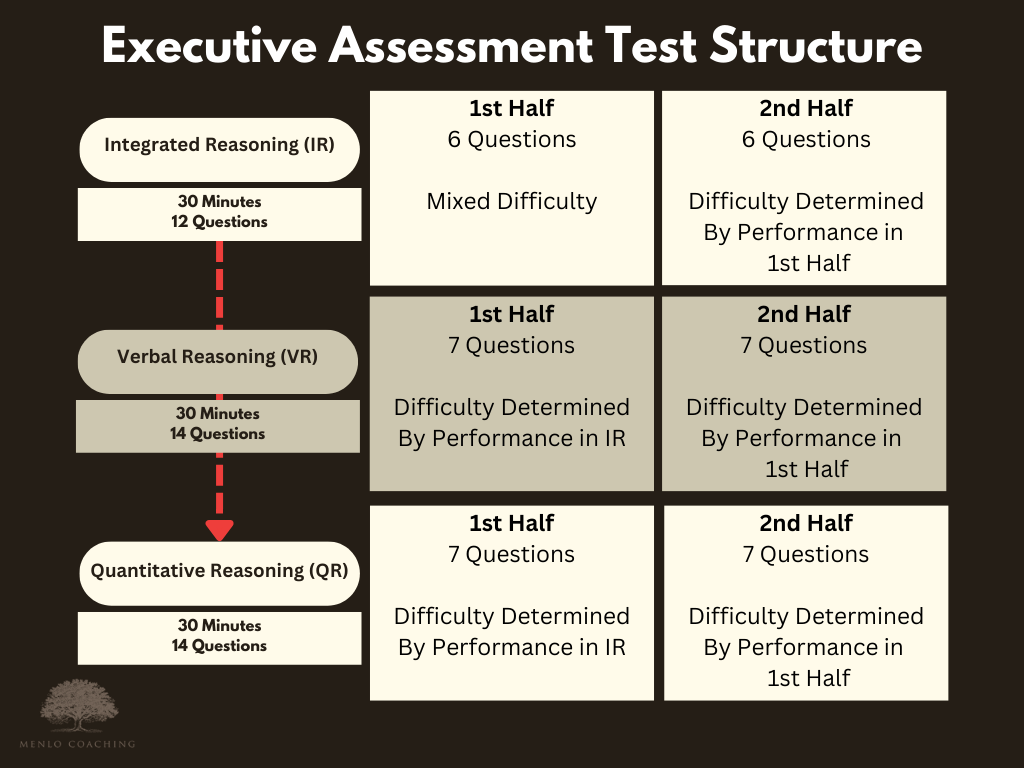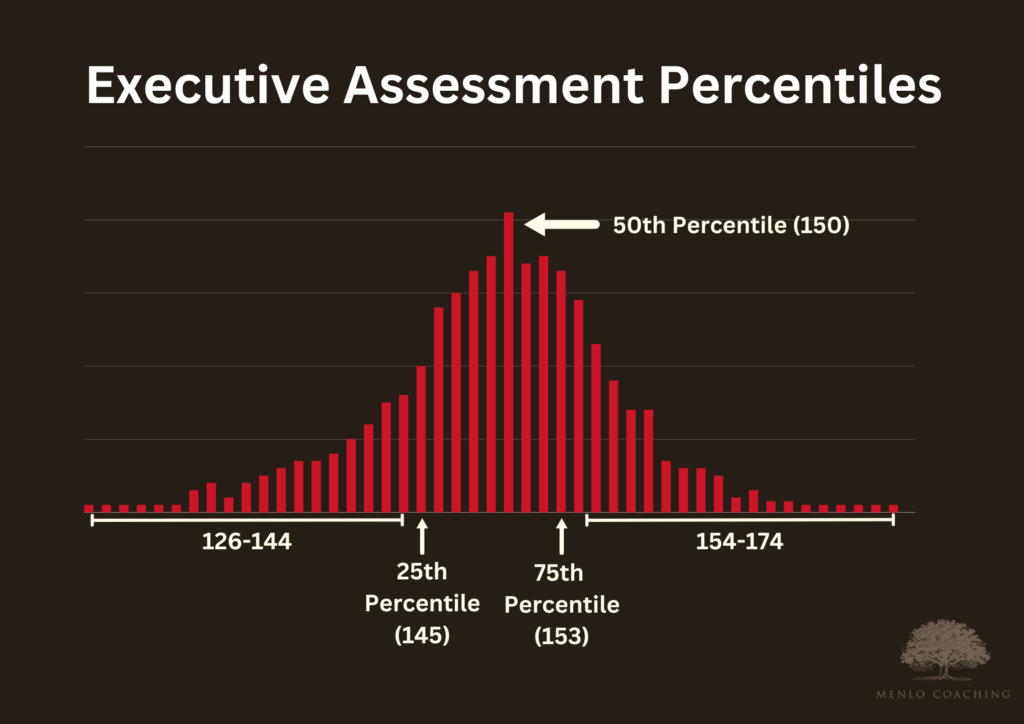The Executive Assessment (EA) is an exam designed by the Graduate Management Admissions Council specifically for Executive MBA program applicants.
EMBA applicants and EA test takers tend to have busy schedules, demanding jobs, and—as a result—not a lot of time to commit to achieving a high score on the GMAT or GRE. To address this lack of spare time, business schools developed a shorter test that you can feasibly prepare for in just four weeks.
Unlike the GMAT, achieving a good Executive Assessment score is really about indicating “business school readiness”, so you shouldn’t think of the EA exam as a competitive race to the highest possible score.
Finding Executive Assessment resources online can be a lot of work, and it can be difficult to determine which information is accurate and up to date.
But we’ve got you covered! In this article, we’ll discuss how Executive Assessment scores are calculated, whether your EA score is competitive, and the significance of EA score percentiles.
The Executive Assessment is broken down into three, 30-minute sections:
When you reach the mid-point of each section, you can return to review the first half of your questions. Note that once you move on to the second half of the section, you will not be able to return to the first half.
You may be wondering: why is there such an emphasis on splitting the sections into halves?
Each section is divided into halves because of the exam’s adaptive algorithm. It works like this:
Now the tricky part: how is the difficulty of the first half of each section determined?
When you start the exam, you’ll be given a set of mixed difficulty IR questions. As we covered, your performance in this first half will determine the difficulty of the second half of IR.
For the rest of the exam, the first halves of VR and QR will be determined by your overall performance in IR.
This means if you perform well in IR, you’ll begin VR and QR with difficult questions. If you give an average performance in IR, you’ll begin VR and QR with medium difficulty questions. And if you perform poorly in IR, you’ll begin VR and QR with easier questions.
It’s always possible to increase or decrease the difficulty of the second halves of VR and QR by performing well in the first halves—nonetheless, when you begin the VR and QR sections, your starting difficulty will be based on your IR performance.
To illustrate this, refer to the chart below.
The adaptive scoring algorithm of the Executive Assessment takes into account the difficulty level of the questions you answered for your total score. Because of this, taking a balanced, holistic approach to pacing in each section while minimizing low value-add time is one of the central strategies we employ at Menlo Coaching.

Executive MBA programs don’t evaluate EA scores in the same way that MBA programs look at GMAT scores. That is, because the Executive Assessment is a readiness test, the goal is not to earn “the highest score possible,” as it is on the GMAT.
Unlike the GMAT, an EA score is a small component of an overall EMBA application. And other factors, such as your leadership experience, employment history, career goals, and professional accomplishments, will be given more weight than your EA score.
Still, a “good” score EA score should at least be in line with your target school’s average. For the top EMBA programs, a score in the mid-150s should be enough—alongside a solid application—to demonstrate your preparedness for your the EMBA.
Note that although GMAC reports that the maximum possible score for the EA is 200, percentile rankings, records of admitted students, and multiple reputable sources indicate that no one has ever scored higher than 174 on the EA.
Due to the nature of the Executive Assessment test, most business schools choose not to publish their entering class’ average EA score. Below, you’ll find all the average EA scores publicly available as well as a link containing further information on EMBA programs’ Admissions Requirements.
| Executive MBA Program | Executive Assessment (EA) Score | Test Requirements |
|---|---|---|
| UPenn Wharton Executive MBA | Median: 156 | EA/GMAT score – Required |
| Chicago Booth Executive MBA | Average: 154 | EA/GMAT score – Required |
| UT Austin McCombs Executive MBA | Average: 154 | EA/GMAT or GRE score – Required |
| UVA Darden Executive MBA | Average: 153 Average Range: 140-160 | EA/GMAT or GRE score – Required |
| Columbia Business School Executive MBA | Average Range: 148-150 | EA/GMAT or GRE score – Required |
| Yale SOM Executive MBA | Average: 151 | EA/GMAT or GRE score – Required |
The following EMBA programs do not release average or median Executive Assessment Scores.
| Executive MBA Program | Test Requirements |
|---|---|
| Northwestern Kellogg Executive MBA | EA/GMAT score – Optional |
| Michigan Ross Executive MBA | EA score – Optional, GMAT score – Required |
| NYU Stern Executive MBA New York City NYU Stern Executive MBA Washington, DC Trium Executive MBA: HEC Paris/LSE/NYU Stern | EA/GMAT or GRE score – Optional EA/GMAT or GRE score – Optional EA score – Optional, GMAT or GRE score – Required |
| UC Berkeley Haas Executive MBA | EA/GMAT or GRE score – Required |
| Duke Fuqua Global Executive MBA Duke Fuqua Weekend Executive MBA | EA/GMAT or GRE score – Required EA/GMAT or GRE score – Required |
| MIT Sloan Executive MBA | EA/GMAT score – Optional |
| UCLA Anderson Executive MBA | EA/GMAT or GRE score – Optional |
| UNC Kenan-Flagler Evening Executive MBA UNC Kenan-Flagler Weekend Executive MBA UNC Kenan-Flagler Charlotte Executive MBA | EA score – Optional, GMAT or GRE score – Required EA score – Optional, GMAT or GRE score – Required EA score – Optional, GMAT or GRE score – Required |
| Cornell Executive MBA Americas Cornell Executive MBA Metro NY Cornell Executive MBA/MS in Healthcare Leadership | EA/GMAT or GRE score – Optional EA/GMAT or GRE score – Optional EA/GMAT or GRE score – Optional |
| Emory Goizueta Executive MBA | EA/GMAT or GRE score – Optional |
| Georgetown McDonough Executive MBA | EA/GMAT or GRE score – Optional |
| UW Foster Executive MBA | EA/GMAT or GRE score – Optional |
Executive Assessment percentiles indicate where your score sits in relation to the scores of other test takers. Unfortunately, as a test taker, you will not have access to this information—only your score recipients will be able to see where your score falls in the percentiles.
However, unlike the GMAT, only three score percentiles are available: the 25th percentile, 50th percentile, and 75th percentile.
The Executive Assessment deliberately withholds information on percentiles in order to prevent a hyperfocus on test scores developing in the EMBA landscape. Further, because fewer people take the Executive Assessment, percentile rankings are generally considered less indicative of talent and ability than GMAT or GRE score percentiles.
As we’ve mentioned, the EA is about measuring how ready you are for business school, not about proving your aptitude for business—your career will illustrate that sufficiently.

One of the advantages (and disadvantages) of the Executive Assessment is that you have a lifetime limit of four tests—you can take up to two exams in a test center and up to two exams online.
While this means that you will only have to take a maximum of four tests, it also means that you’ve only got four attempts to earn the right EA score for your target EMBA programs.
That means that it’s important to work smarter—not harder—when it comes to the EA.
Start by taking a practice test to diagnose your strengths and weaknesses. Although many people struggle with Integrated Reasoning, others find that their scores are negatively affected by poor scores in the Quantitative Reasoning or Verbal Reasoning sections.
Then, spend some time refreshing the materials. GMAC, the developers of the Executive Assessment, recommend that test takers spend about 4 weeks preparing for the EA, taking approximately 1-2 hours per day to study the material.
For busy professionals, speaking with an EA tutor is often the best idea, as tutors have a strong grasp on both the content of the Executive Assessment and the strategy that goes into maximizing your score with minimal prep time.
It’s also advisable to devise an EA study plan to make sure that you aren’t getting bogged down by the practicalities of deciding what to study during the time you’ve allocated to improve your score.
If you’d like expert help improving your EA score, contact our Executive Assessment tutoring team.
We’ll help you construct a plan to maximize your score within a reasonable time frame and take the guesswork out of preparing for the Executive Assessment.